SuPerMan
In short
SuPerMan: Structure Preserving schemes for Conservation Laws on dynamic Space Time Manifolds
MSCA-IF funded project under the Horizon 2020 programme, grant agreement No 101025563.
Period: 01/06/2021 -- 31/05/2023.
Budget: 184.700 euros
Abstract & Objectives
SuPerMan proposes the development and efficient implementation of new structure preserving schemes for conservation
laws formulated in an elegant and universal form through covariant derivatives on spacetime manifolds.
Indeed, nonlinear systems of hyperbolic PDEs are characterized by invariants, whose preservation at the discrete level is not
trivial, but plays a fundamental role in improving the long term predictivity and reducing the computational effort of modern
algorithms. Besides mass and linear momentum conservation, typical of any Finite Volume scheme, the preservation of
stationary and moving equilibria, asymptotic limits and interfaces still represents an open challenge, especially in
astrophysical applications, such as turbulent flows in gas clouds rotating around black holes.
In this project, our focus will thus be on General Relativistic Hydrodynamics (GRHD) for which such Well Balanced (WB)
Structure Preserving (SP) schemes have never been studied before. In particular, we plan to devise smart methods,
independent of the coordinate system. This will be achieved by directly including the metric, implicitly contained in the
covariant derivative, as a conserved variable inside the GRHD model.
This approach will first be tested on the Euler equations of gasdynamics with Newtonian gravity, extending already existing
WB-SP techniques to general coordinate systems. All novel features will be carefully proven theoretically. Next, the new
schemes will be incorporated inside a parallel high order accurate direct Arbitrary-Lagrangian-Eulerian Finite Volume
(FV) and Discontinuous Galerkin (DG) code which will be also further improved during the project.
Main results of this 2 years research project.
Publications: 6 accepted papers, 1 book chapter, 1 proocedings, 1 paper submitted, 1 paper in preparation
(see below for a list of the pubblications and a summary of the obtained results)
Organized events: 1 international conference (MultiMat 2022), 1 regional workshop (2021), 2 PhD schools (2022 & 2023)
Participation in: 12 international conferences and workshops + 5 laboratory seminars
Open positions on new research funds (obtained in Summer 2023)
Available 1 Post Doc position starting from November/December 2023 or January 2024:
(the online open call will be available soon)
Title:
High order Lagrangian Discontinuous Galerkin schemes on moving Voronoi meshes for the solution of hyperbolic equations
If you would like to apply, or if you need any further information, please contact me by email! (elena.gaburro@inria.fr)
The work modality can be agreed with the selected candidate:
- The exact research topic can be decided together;
- Smart working and output-oriented approach are welcomed;
- Participation to international conferences will be funded and encouraged;
- Research periods abroad in patner institutions can also be funded.
Available on demand: 3 to 6 months internships and 3 years PhD positions
People interested in not yet open positions should send an email to elena.gaburro@inria.fr, including a detailed CV, 2 to 6 months before their preferred starting date.
Possible research topics include: lagrangian schemes on moving meshes with topology changes
(for example: parallelization, moving boundaries, adaptive mesh refinement, new applications, 3D extension ...) and
well balancing for general relativity (using simplified or complete models, in 1D, 2D or 3D, with a theoretical and/or a numerical approach).
Main scientific results
To pursue our objectives, we have worked in 3 directions:
The first, and let’s say classical, consists in investigating how to improve our high order numerical methods.
For example, during SuPerMan we have worked on
1) a shifted boundary polynomial correction to achieve high order of acccuracy on curved domains discretized by simple linear meshes
M. Ciallella, E. Gaburro, M. Lorini, M. Ricchiuto,
High-order shifted boundary polynomial corrections for compressible flows: high order on curved domains using linear meshes.
Applied Mathematics and Computation, 441, 127698, 2023.
Preprint available here.
2) a novel set of basis functions to reduce the computational cost over polygonal meshes
W. Boscheri, M. Dumbser, E. Gaburro,
Continuous Finite Element Subgrid Basis Functions for Discontinuous Galerkin Schemes on Unstructured Polygonal Voronoi Meshes.
Commun. Comput. Phys., 32, 2022.
Preprint available here.
3) the extension of our a posteriori sub-cell Finite Volume limiter to the class of PNPM schemes
E. Gaburro, M. Dumbser,
A Posteriori Subcell Finite Volume Limiter for General P\_NP\_M PNPM Schemes: Applications from Gasdynamics to Relativistic Magnetohydrodynamics
Journal of Scientific Computing, 86, 1--41, 2021.
Preprint available here.
Then, particular attention has been devoted to improving our direct Arbitrary-Lagrangian-Eulerian (ALE) algorithm.
Lagrangian algorithms allow to reduce the numerical dissipation at contact waves and moving material interfaces and guarantee the Galilean and rotational invariance,
so they have very desirable structure preserving features.
However, in these schemes the mesh moves together with the fluid flow,
leading frequently to distortions that may slow down or even destroy the computation.
Thus, to exploit the power of Lagrangian methods always maintaining a high quality of the moving mesh,
we have developed a ground-breaking novel approach that permits the use of mesh optimization techniques and to integrate with high order of accuracy when,
in order to optimize the mesh, we introduce a so-called topology change.
This approach, which makes use of integration on hole-like degenerate elements,
is a novelty introduced by the ER in 2020 and further developed over the years.
Here, we visually describe the key features and the capabilities of our high order direct Arbitrary-Lagrangian Eulerian (ALE) method on Voronoi-type polygonal meshes with topology changes.
1) We cover our domain with a set generator points (orange points) and we connect them via a Delaunay triangulation. Then, around each generator we construct a polygon by connecting the centroids of each triangle (blue points):
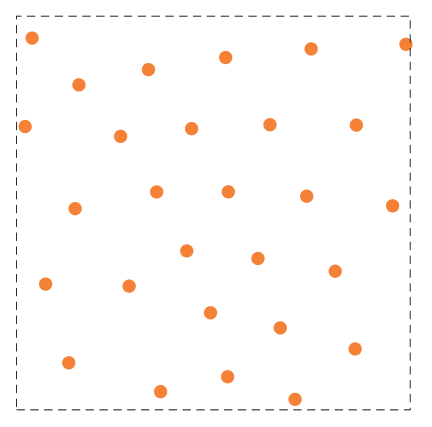
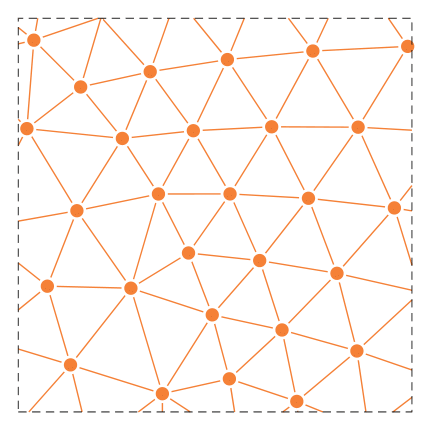
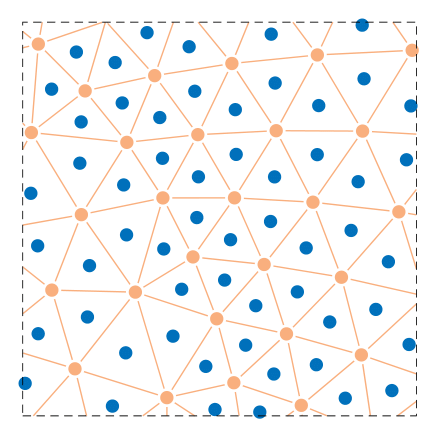
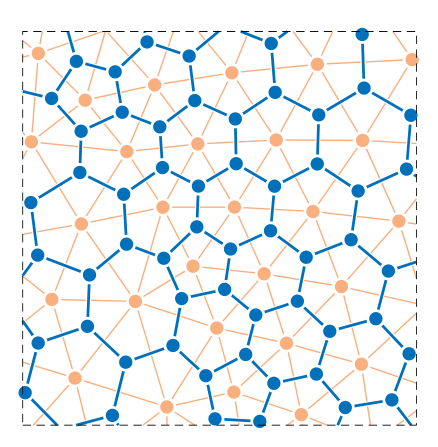
2) We then construct a space-time connectivity that allows to evolve the solution from time t^n up to t^(n+1).
We show here the space time connectivity without (top) and with (bottom) topology changes,
with corresponding standard spacetime control volumes (blue), a simple way to sub-divivide and integrate them, and a degenerate hole-like control volume (pink).
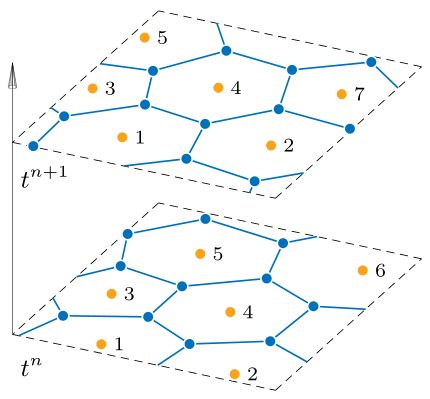
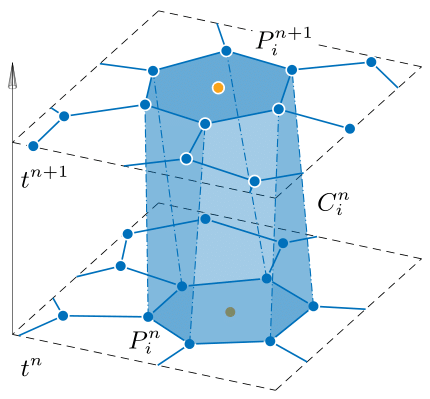
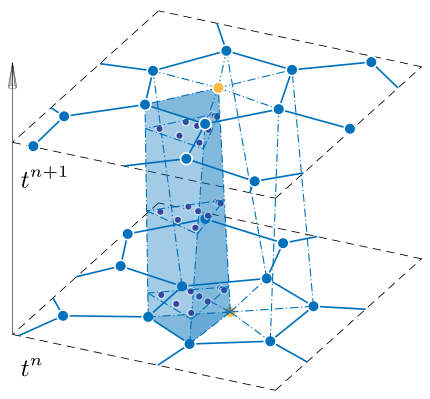
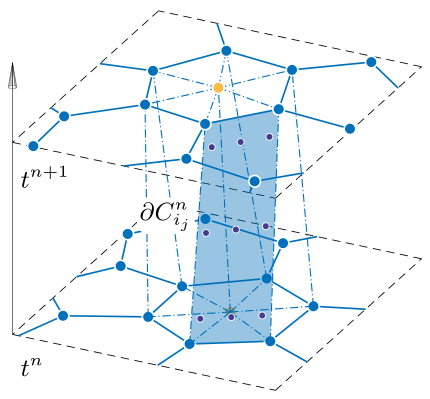
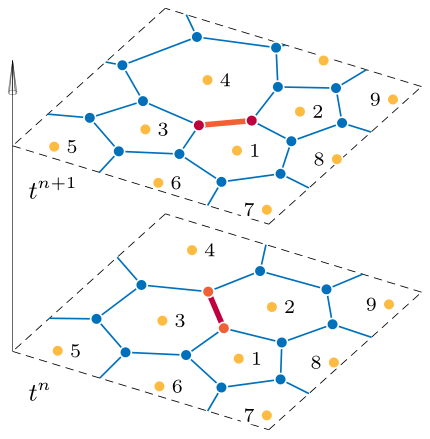
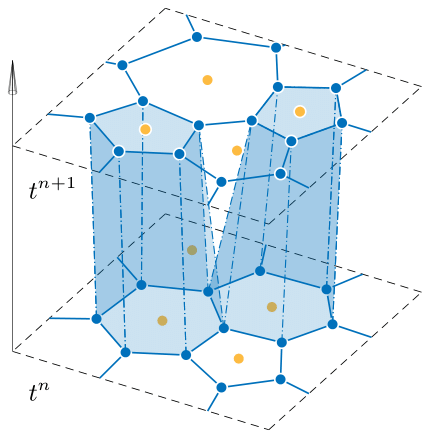
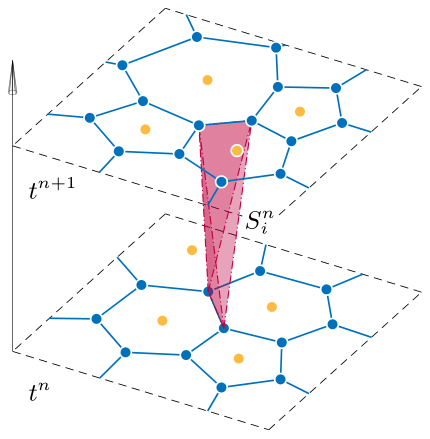
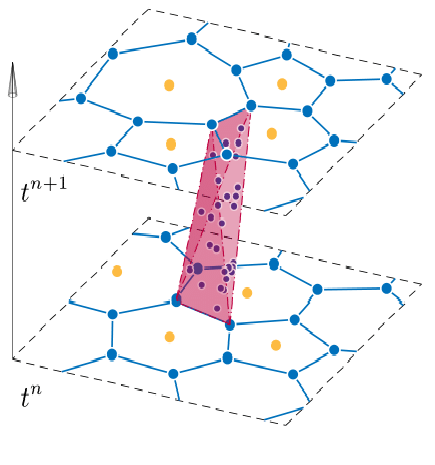
3) We show here an evidence of the advantages of using topology changes.
We plot the mesh evolution corresponding to the solution of the Euler equations of gasdynamics and a stationary rotating Shu vortex.
Top: the simulation is performed on a moving grid with fixed topology.
The mesh quality rapidly deteriorates: elements are stretched and even mesh-tangling occurs,
which means that the simulation has to stop entirely after just 1/4 of a revolution.
Bottom: thanks to topology changes the mesh has a perfect quality also after 100 complete revolutions. Moreover, in this second case, thanks to our capability
of dealing with topology changes at high order of accuracy we also obtain a high quality solution (visually identical at the beginning and the end of the simulation):
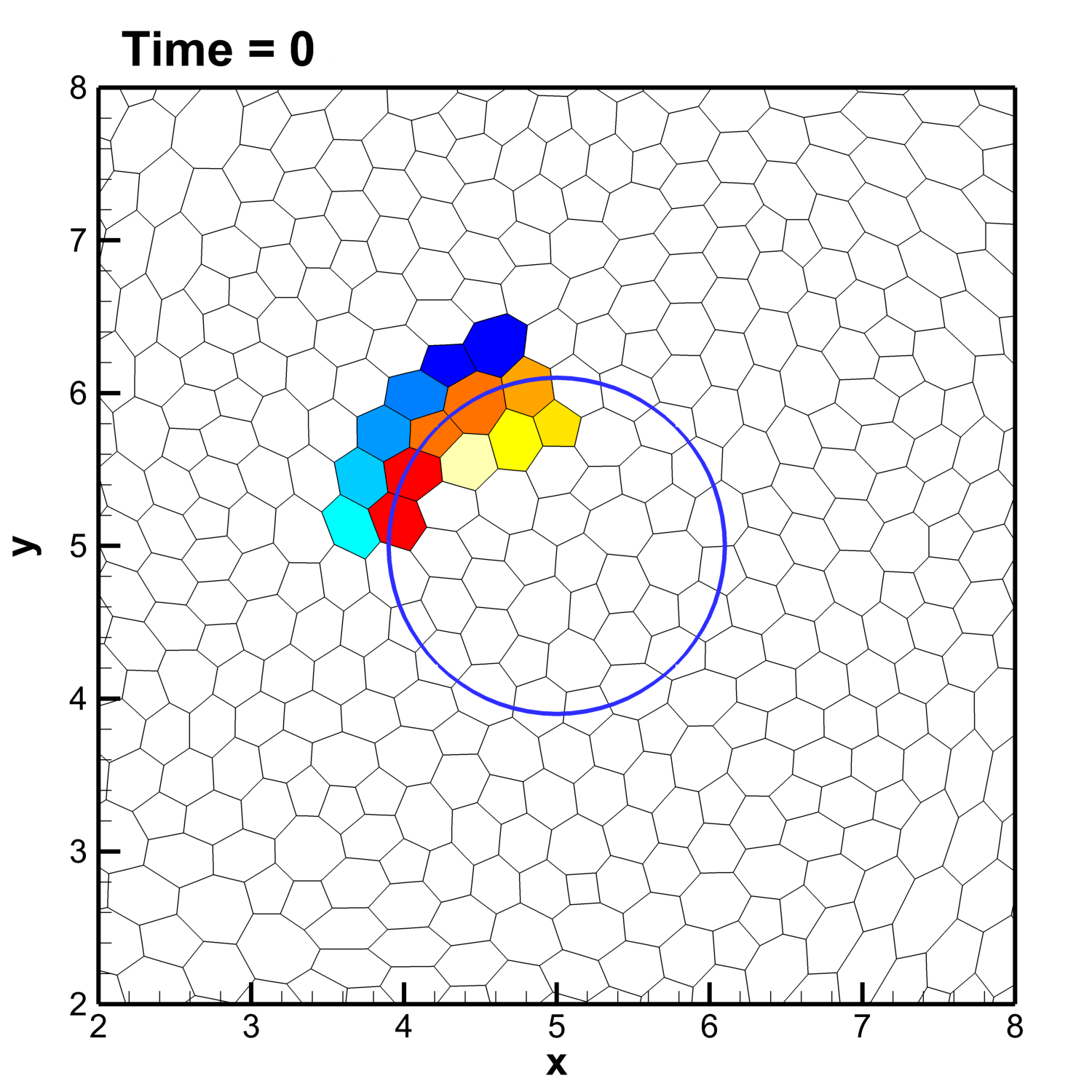
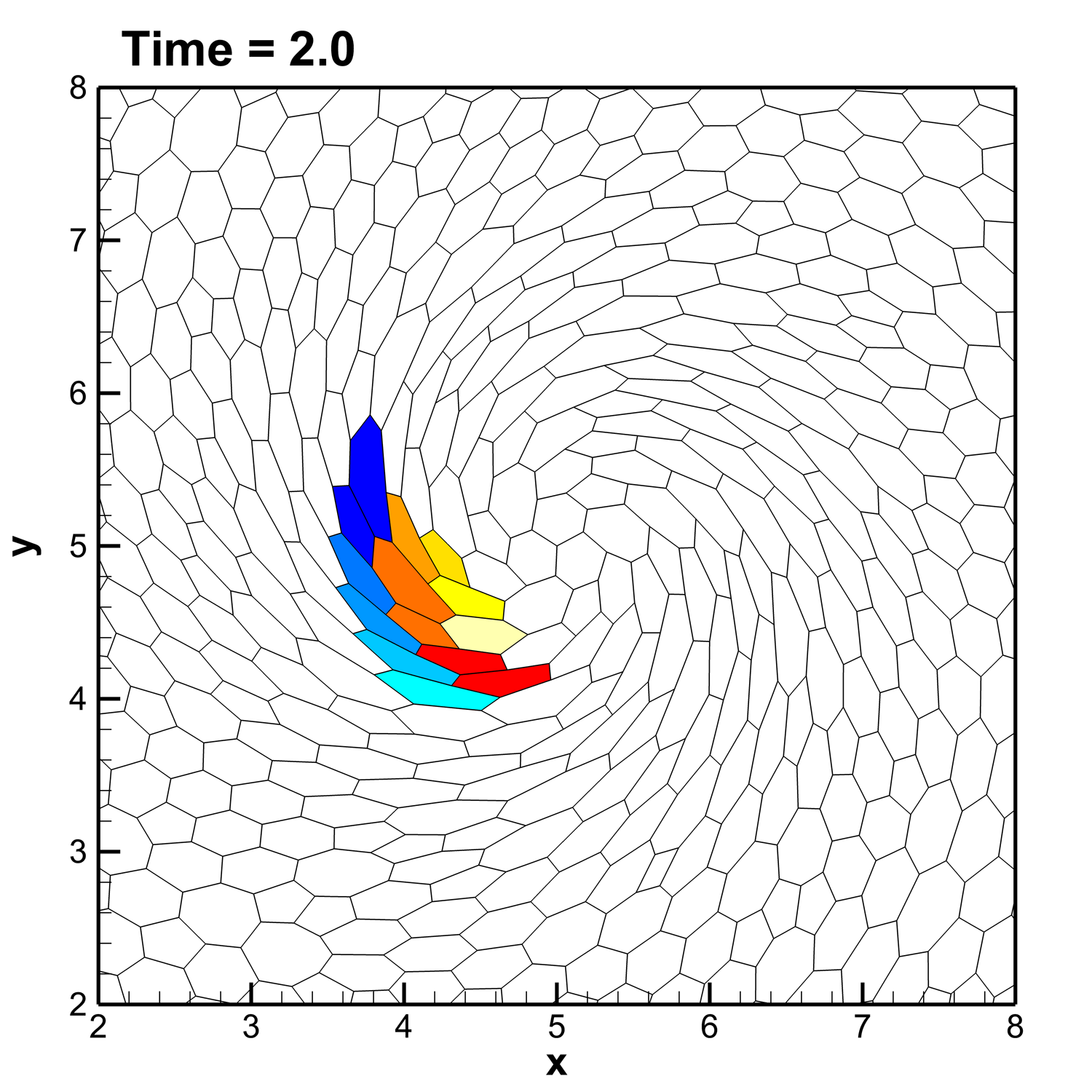
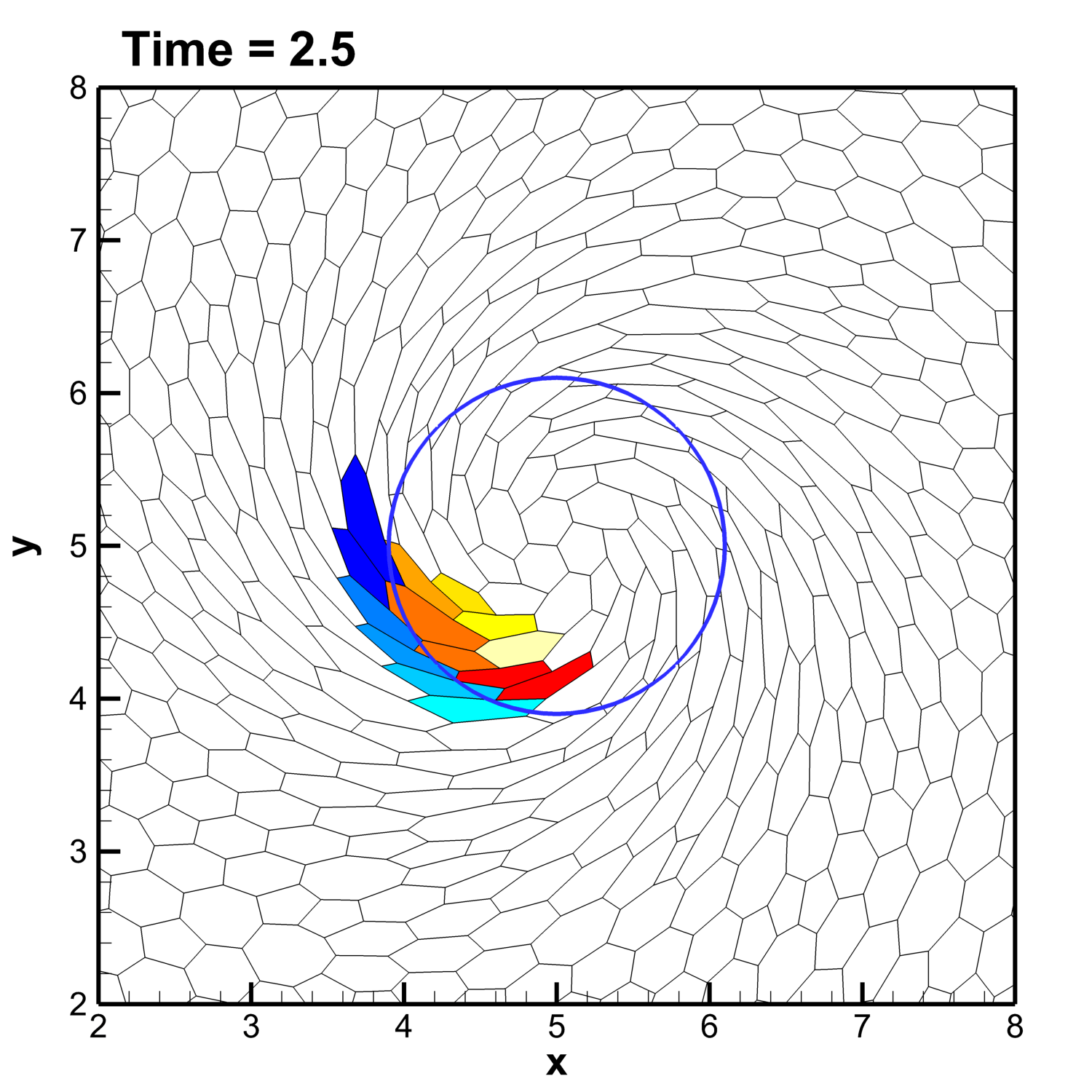
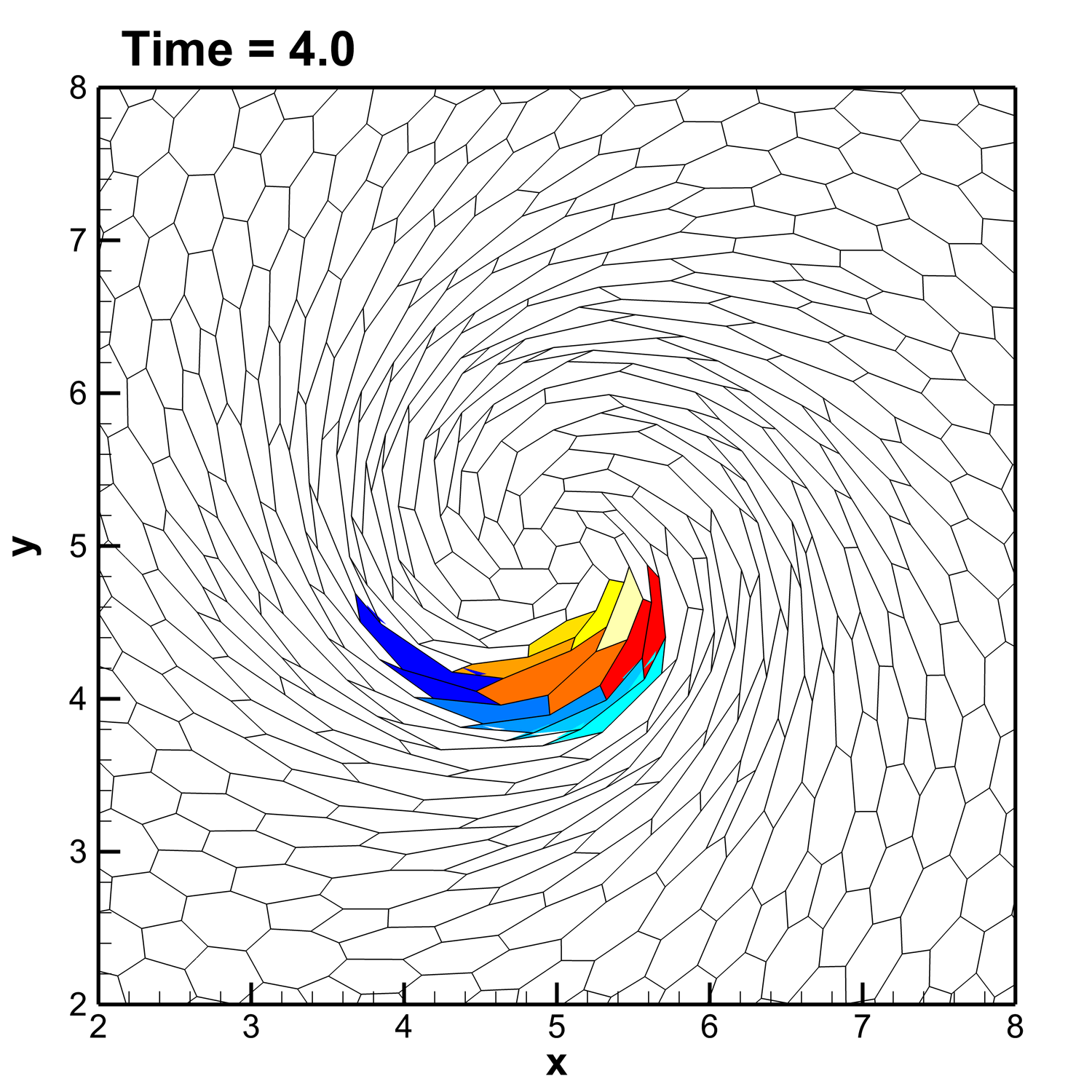
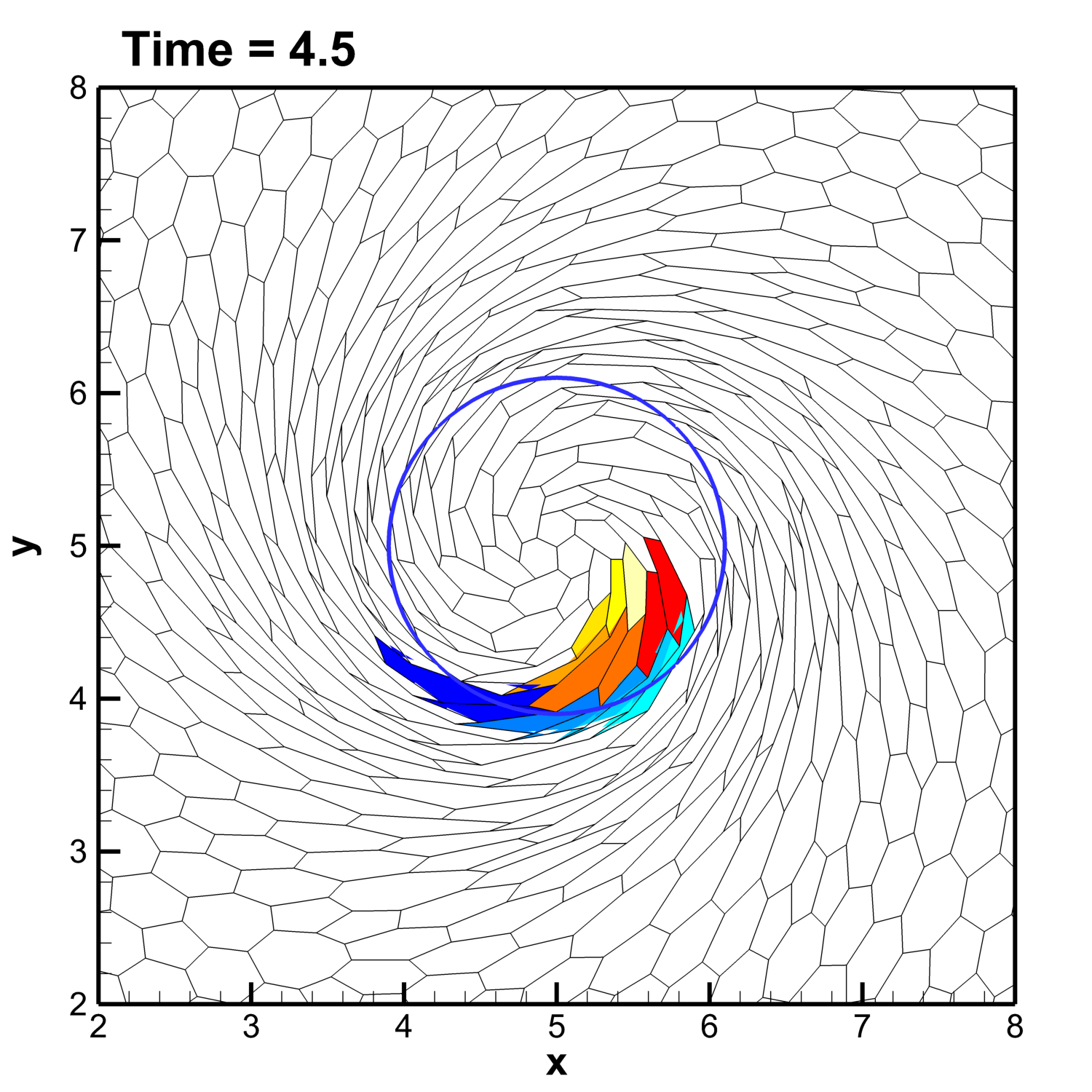
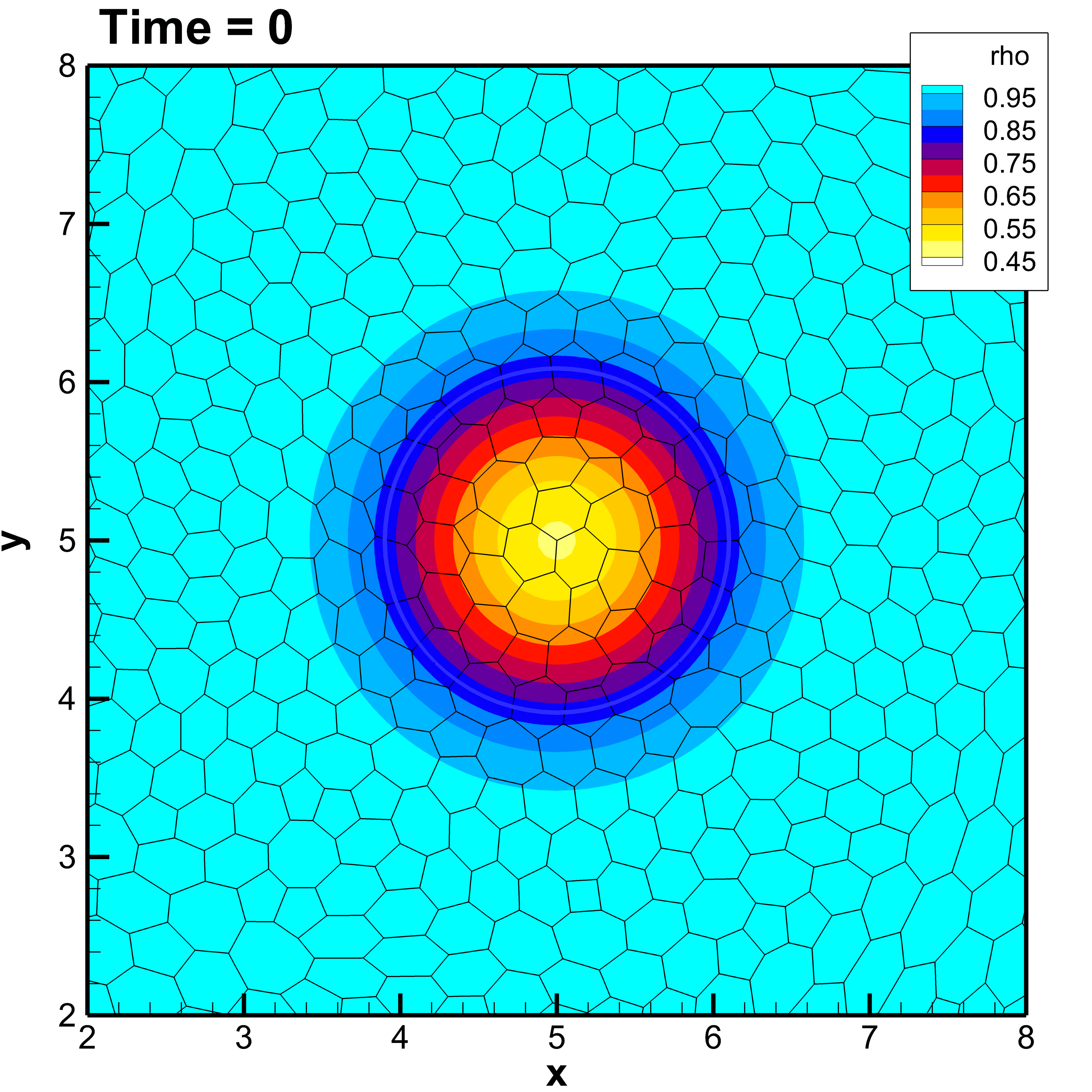
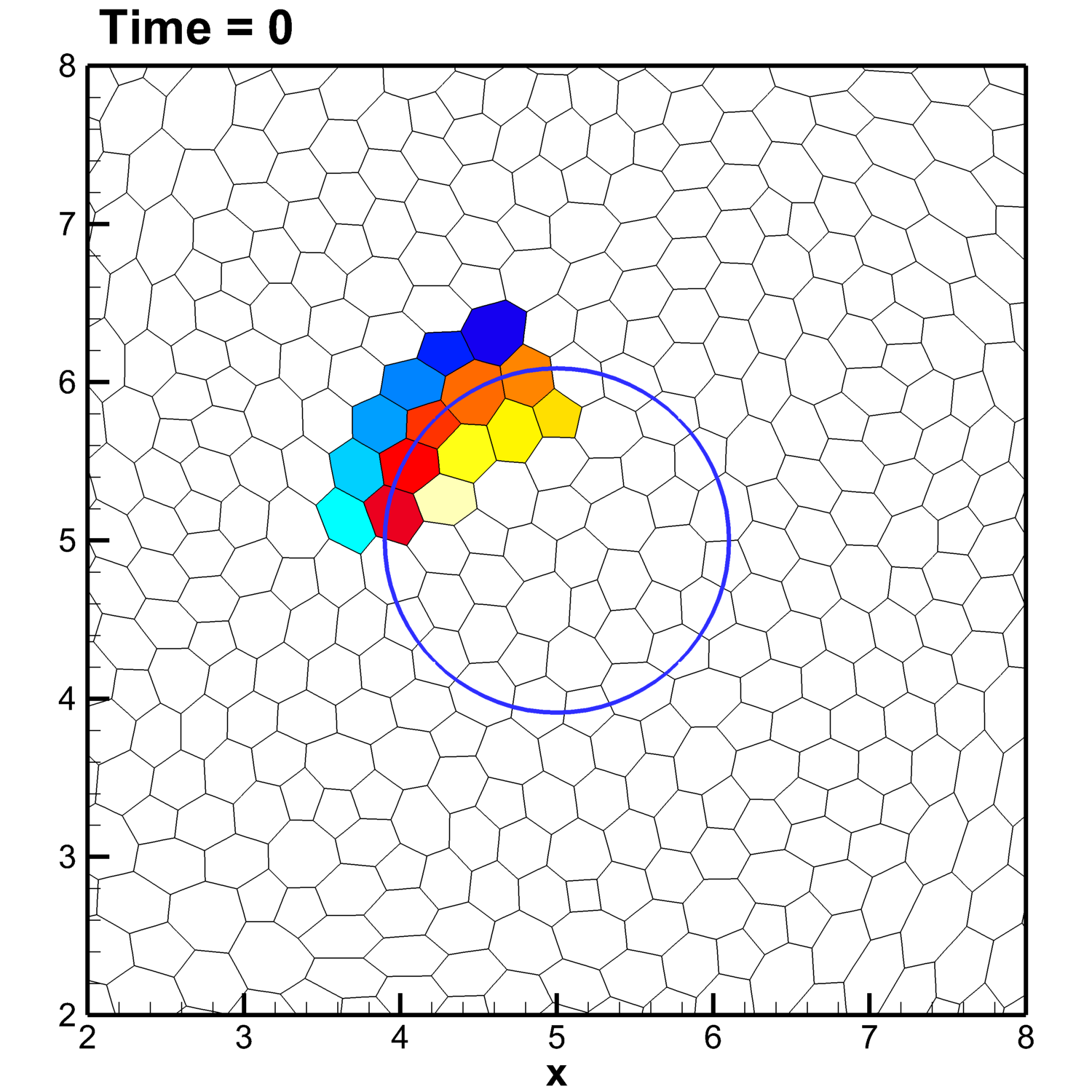
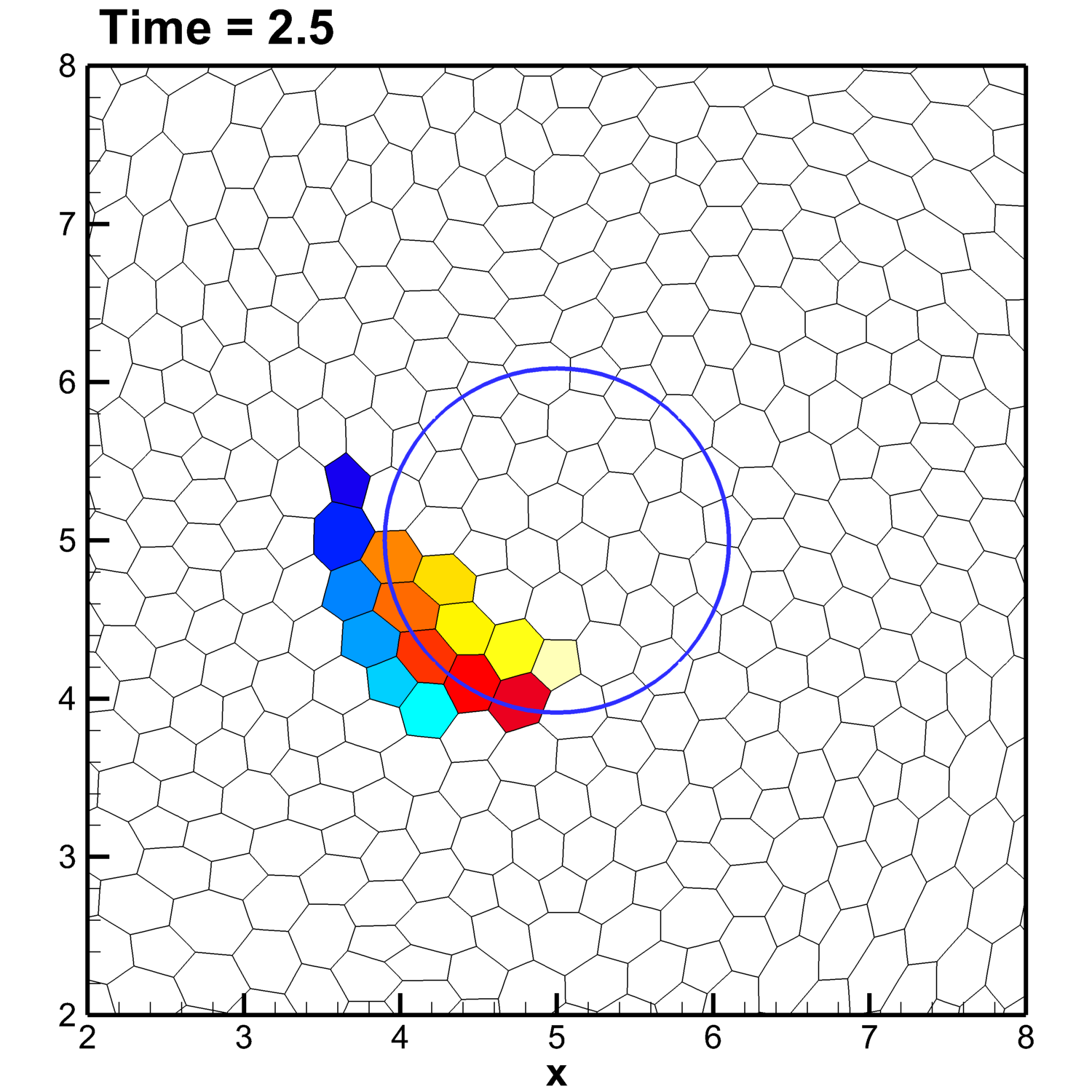
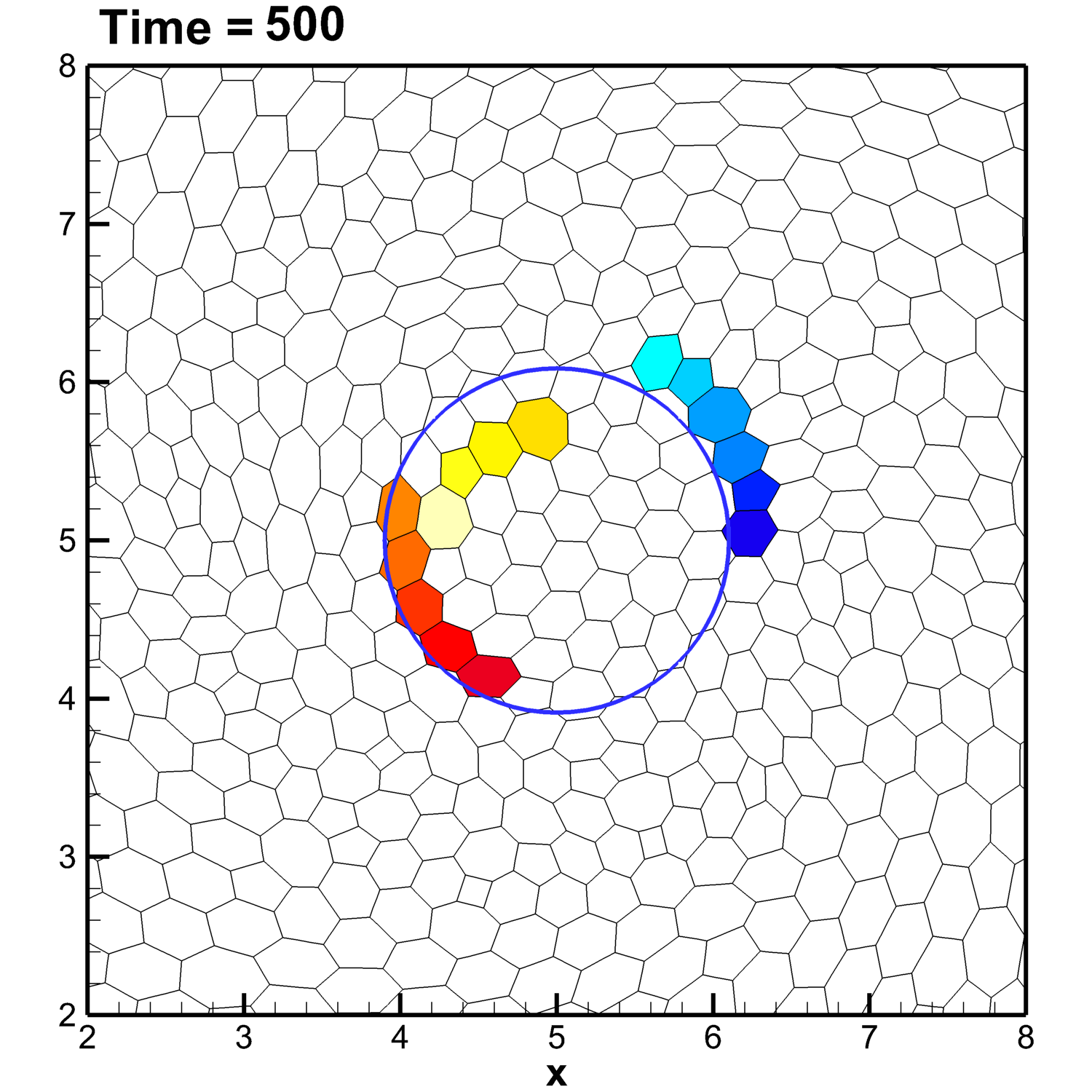
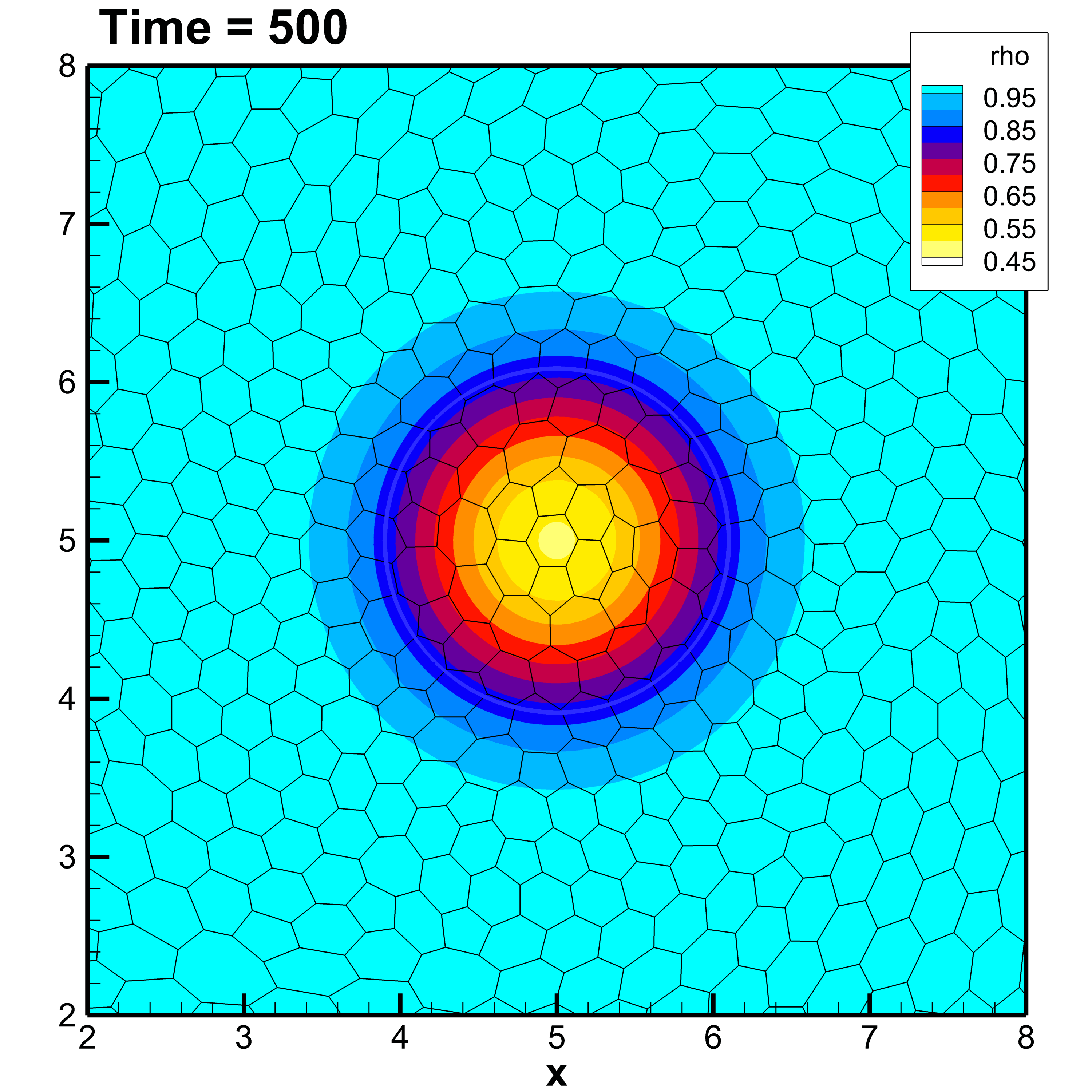
Main collaborator: S. Chiocchetti, University of Stuttgart, Germany.
Pubblication: High-order Arbitrary-Lagrangian-Eulerian schemes on crazy moving Voronoi meshes. E. Gaburro, S. Chiocchetti.
Numerical aspects of hyperbolic balance laws and related problems, Sema Simai, Springer, vol. 32, 2023.
Preprint available here.
The third main activity of this research project concerns the introduction of the above
described schemes of novel structure preserving techniques guaranteeing entropy stability
(see this paper)
and preservation of equilibria.
Well-balancing is a technique able to guarantee the exact preservation of equilibria
thus allowing to model with higher accuracy the small physical perturbations
happening around equilibria profiles.
We employed these techniques for different applications of increasing difficulties,
many of which are unfeasible without the present technologies,
thus representing a major enhancement in the community of computational astrophysics:
1) For modelling Shallow Water equations in covariant coordinate (https://arxiv.org/abs/2209.01036).
Note that this simpler work allowed us to better understand how
to deal with metric variables inside our physical model, hence it represented
a valid starting point for the work described here below.
2) For modelling GRMHD and Einstein field equations in 1D (https://arxiv.org/abs/2108.02960).
For example we have been able to simulate a TOV neutron star modeled thanks to
our first order hyperbolic reformualtion of the coupled Einstein-Euler system.
In particular, in this test case we have studied the effect of an initial perturbation of the metric variable K.
We show in the images below the effects of this perturbation over the density profile (left) and the lapse metric value (middle).
We also show the respect of the Hamiltonian and momentum involution constraints (right).
We notice in particular that this simulation is stable over long computational times
only when the code is equipped with our well-balanced techniques,
otherwise the simulation blows up even on very fine meshes (four times finer 4x).
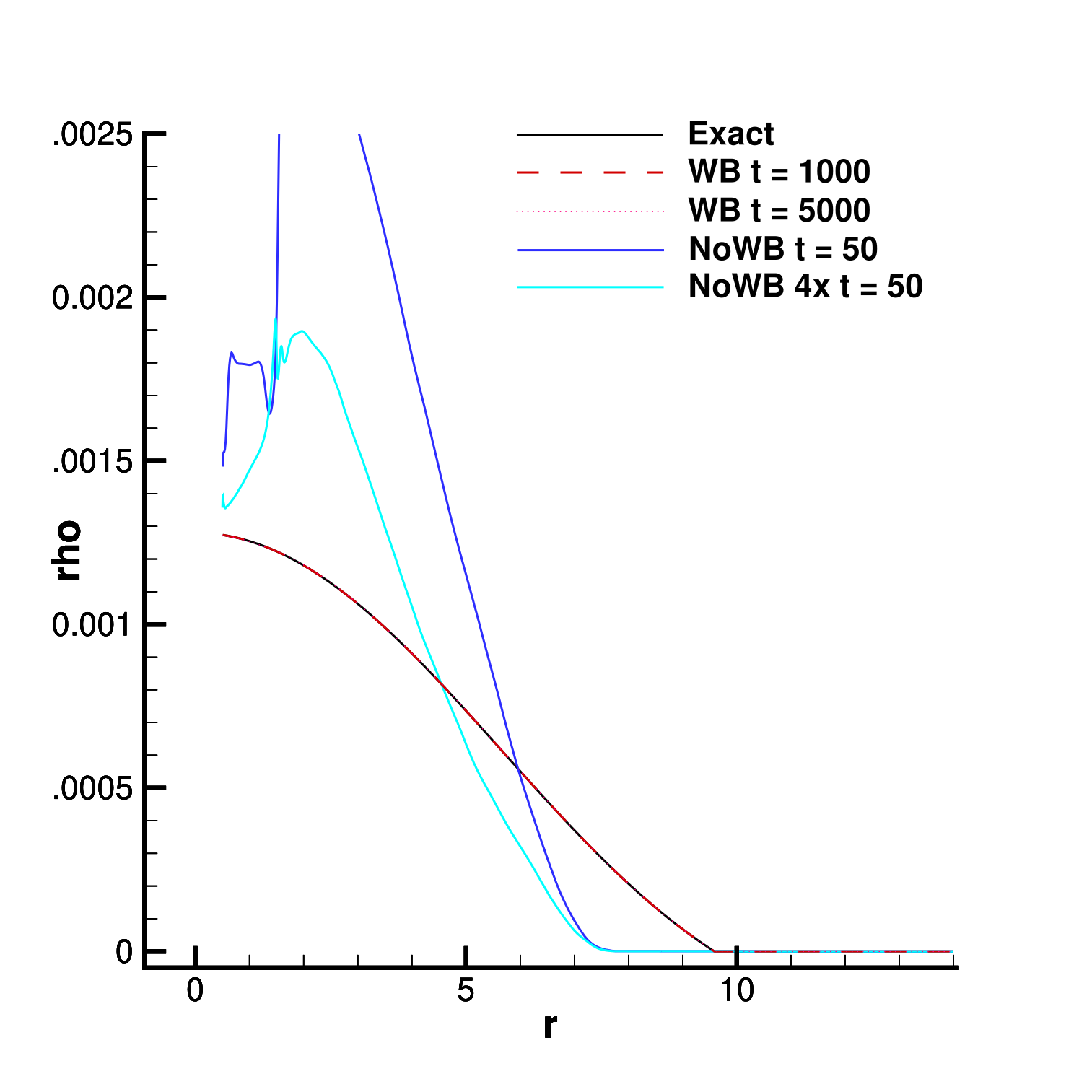
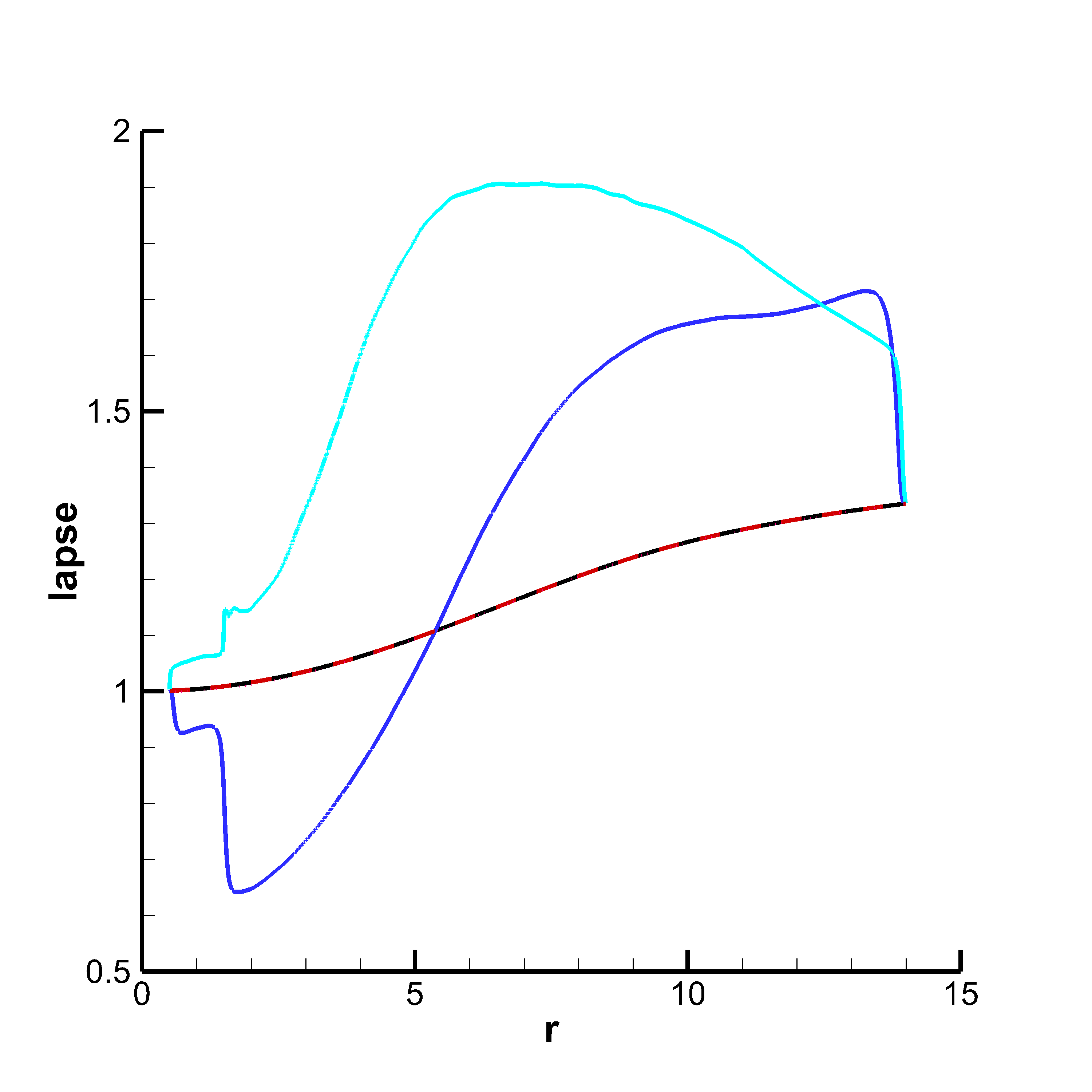
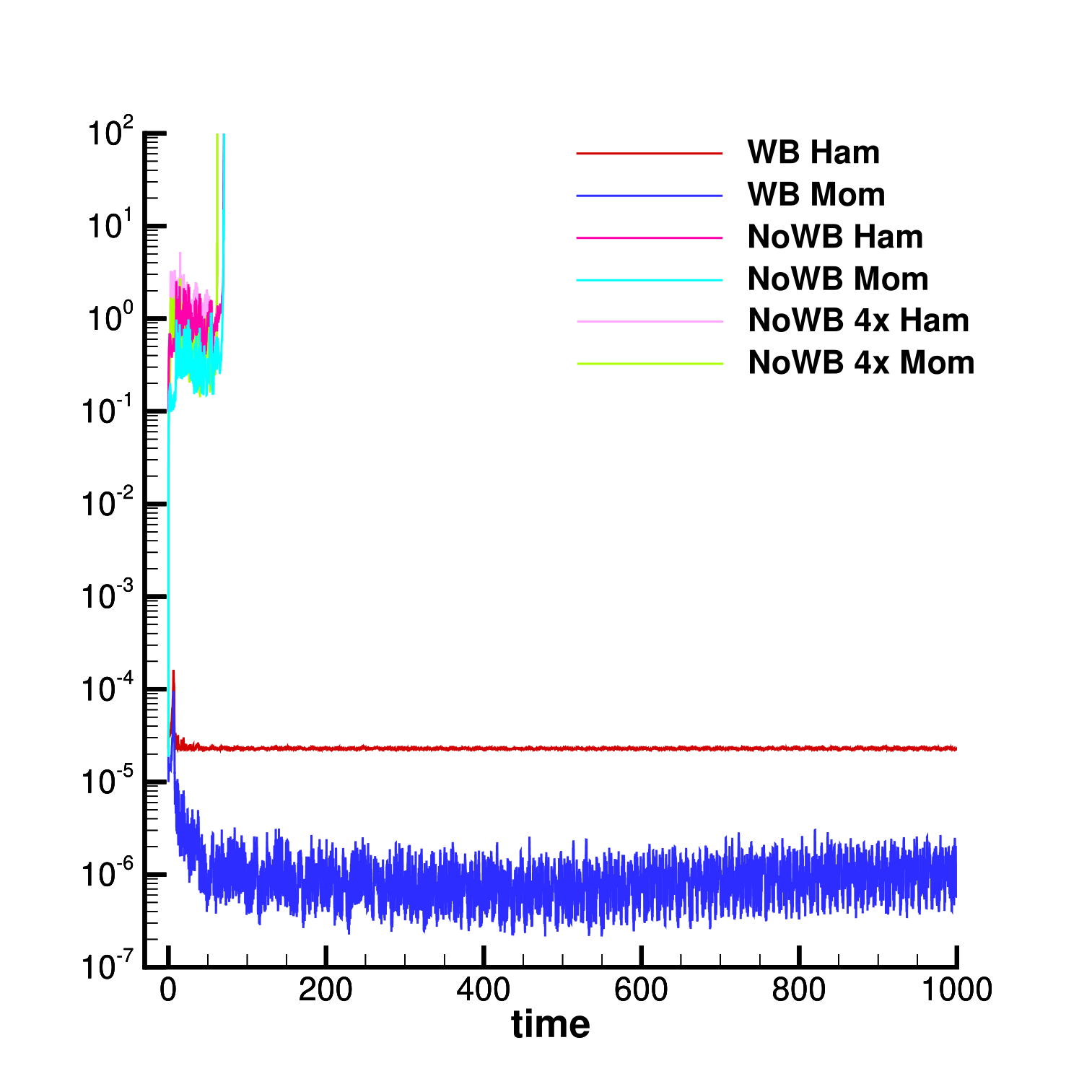
In the next set of images we show the effect of an intial perturbation imposed over the pressure profile.
Again we show the values of the Hamiltonian and momentum constraints (left)
which are close to machine precision and constantly maintained for long computational times with the WB code,
while they rapidly blow up with the not WB code.
Right: we plot the numerical results obtained with the new WB scheme for the density of the star at an inner point with r=0.5
which oscillates due to the initial pressure perturbations.
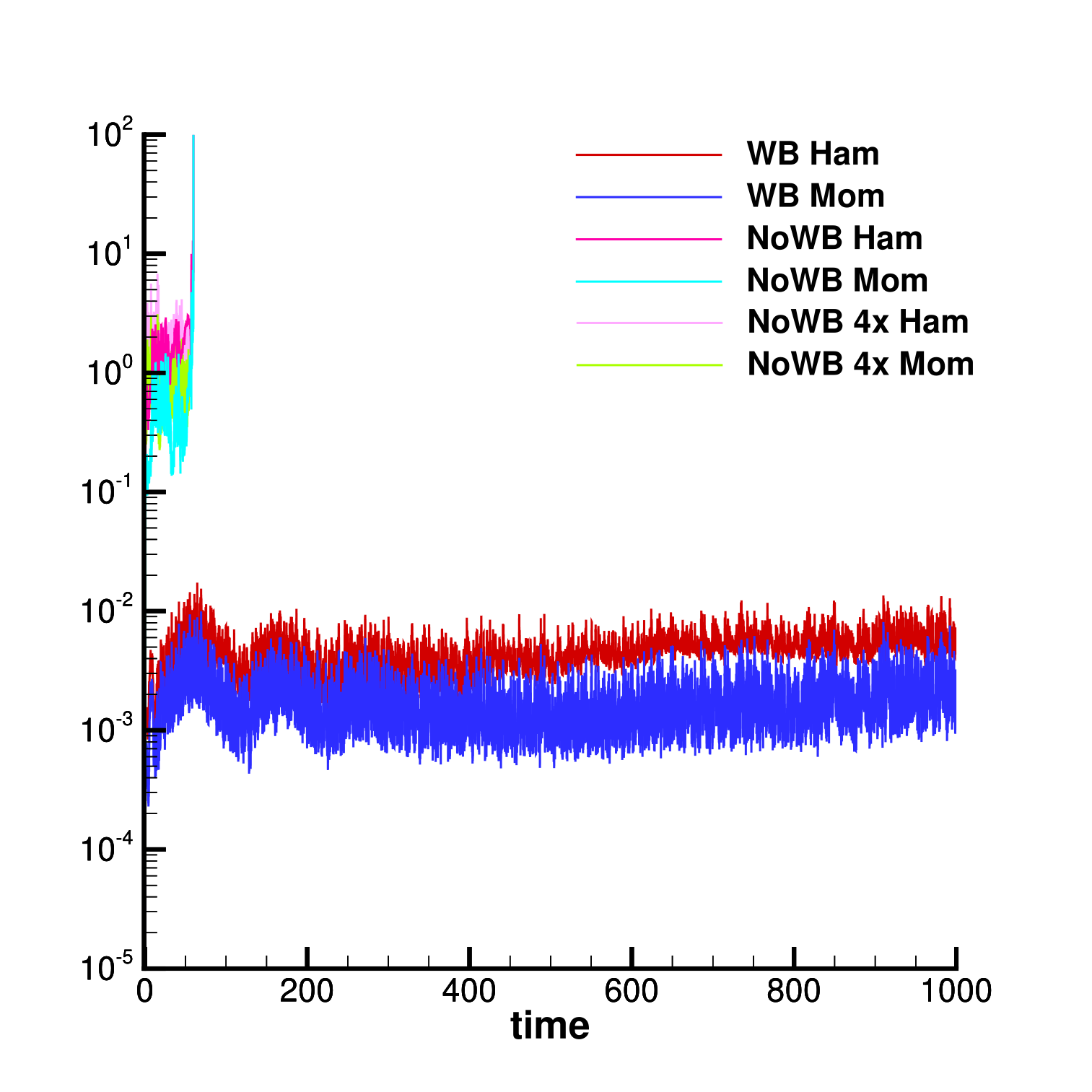
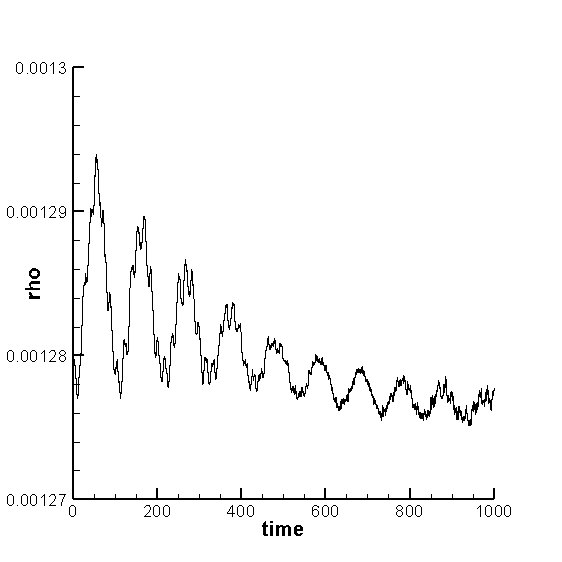
For more details, have a look to our paper.
Main collaborator: M.Dumbser, University of Trento (Italy) and M.J. Castro, University of Malaga (Spain).
3) For increasing the capabilities of our direct ALE method with topology changes (fully described in the previous section)
and modelling instabilities over Keplerian disks.
Here below, we study the evolution of a sinusoidal perturbation imposed over an equilibium
profile showing a steep density gradient.
We can notice that our ALE+WB method capture in a sharper way the Kelvin-Helmholtz perturbation profiles with respect to a standard Eulerian method.
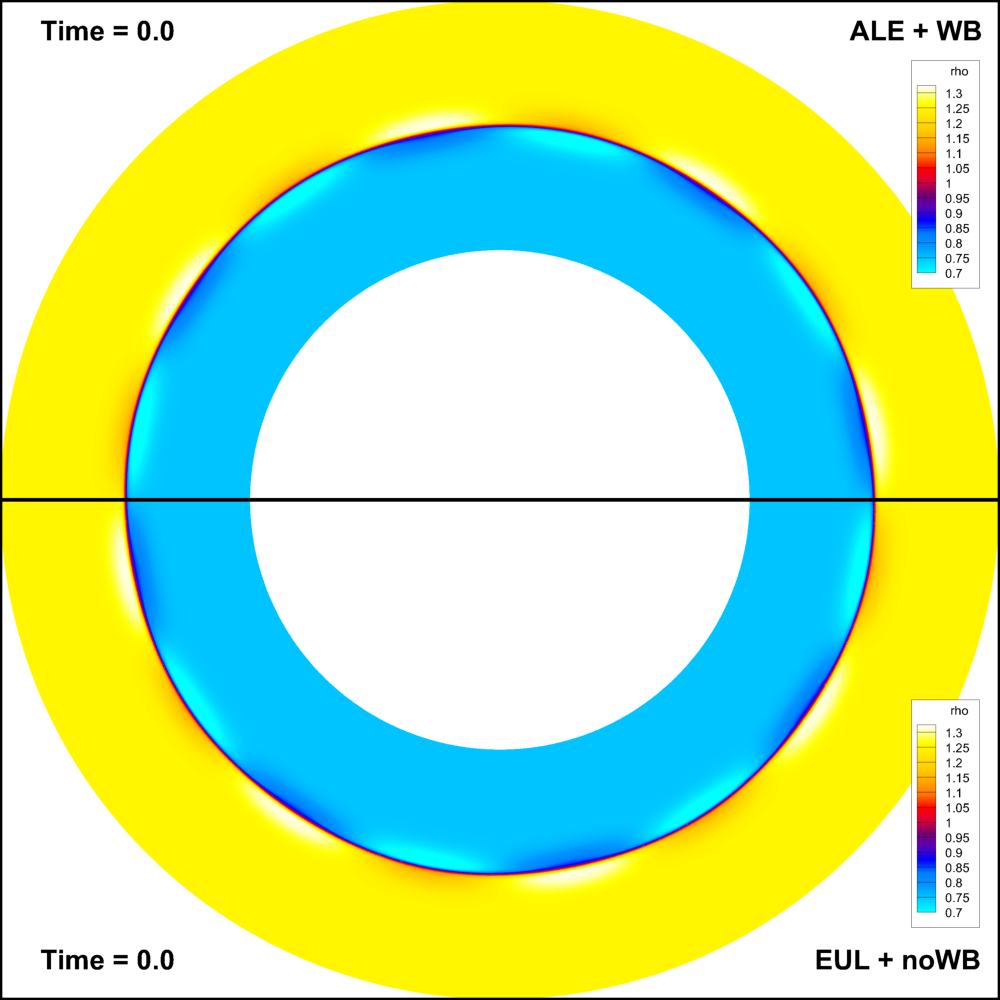
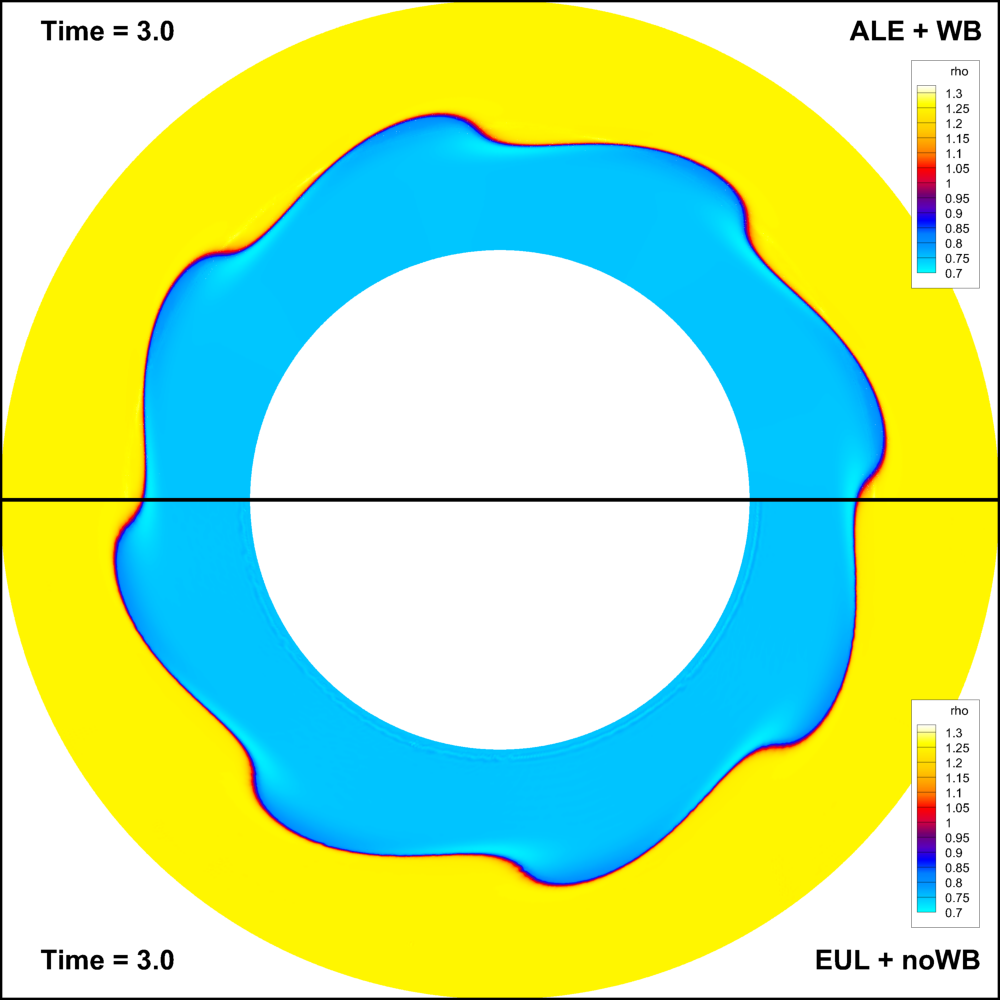
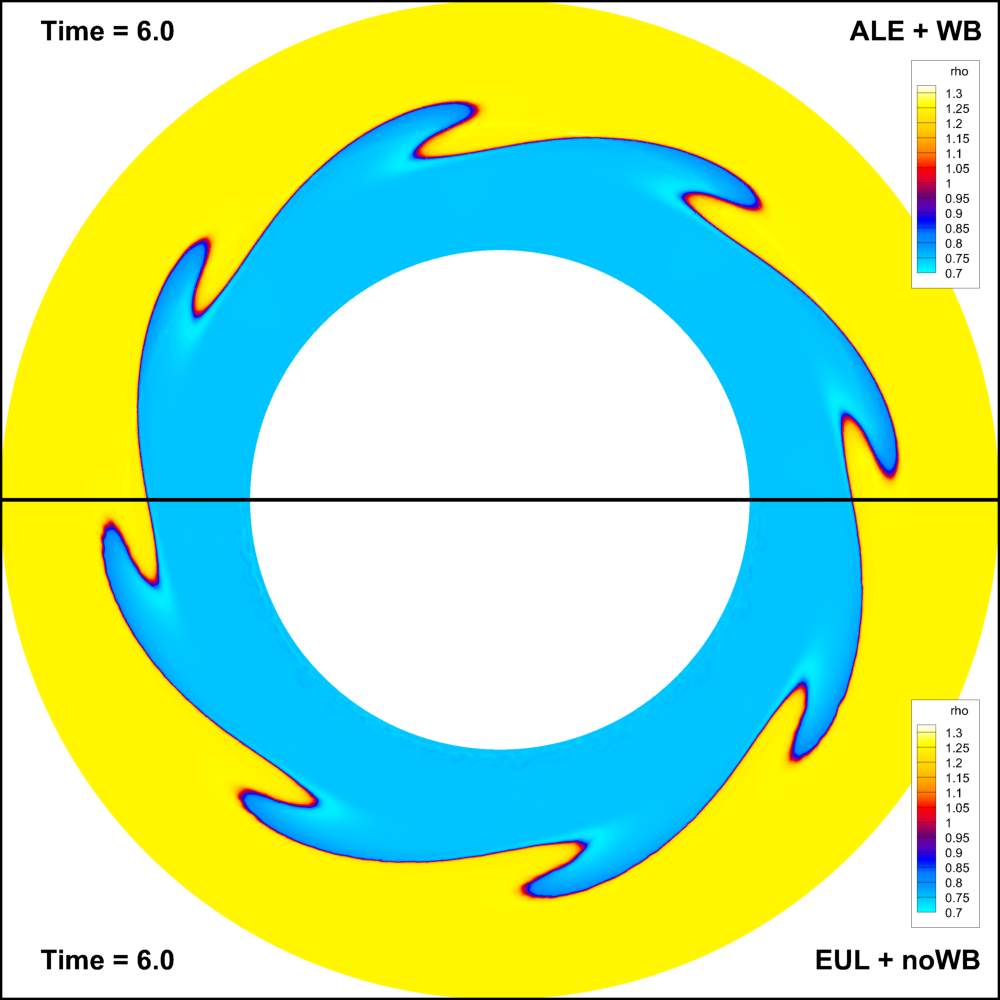
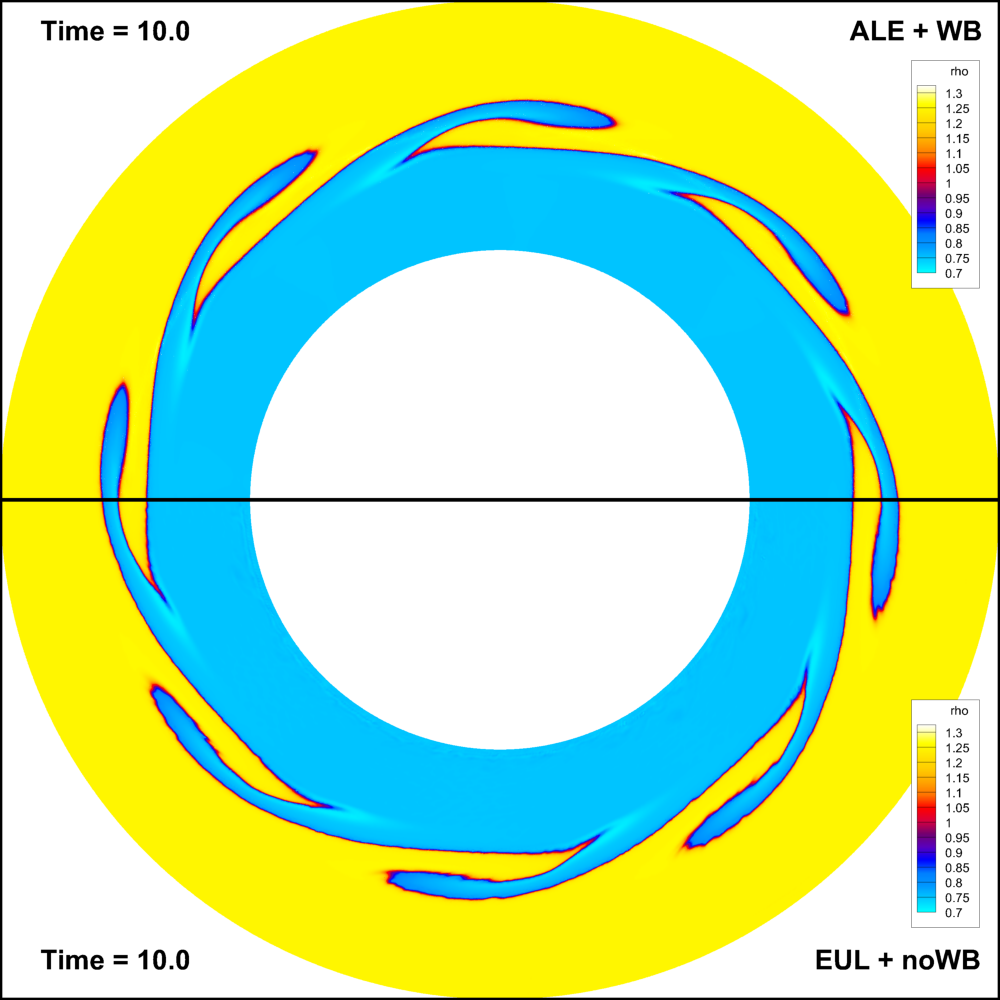
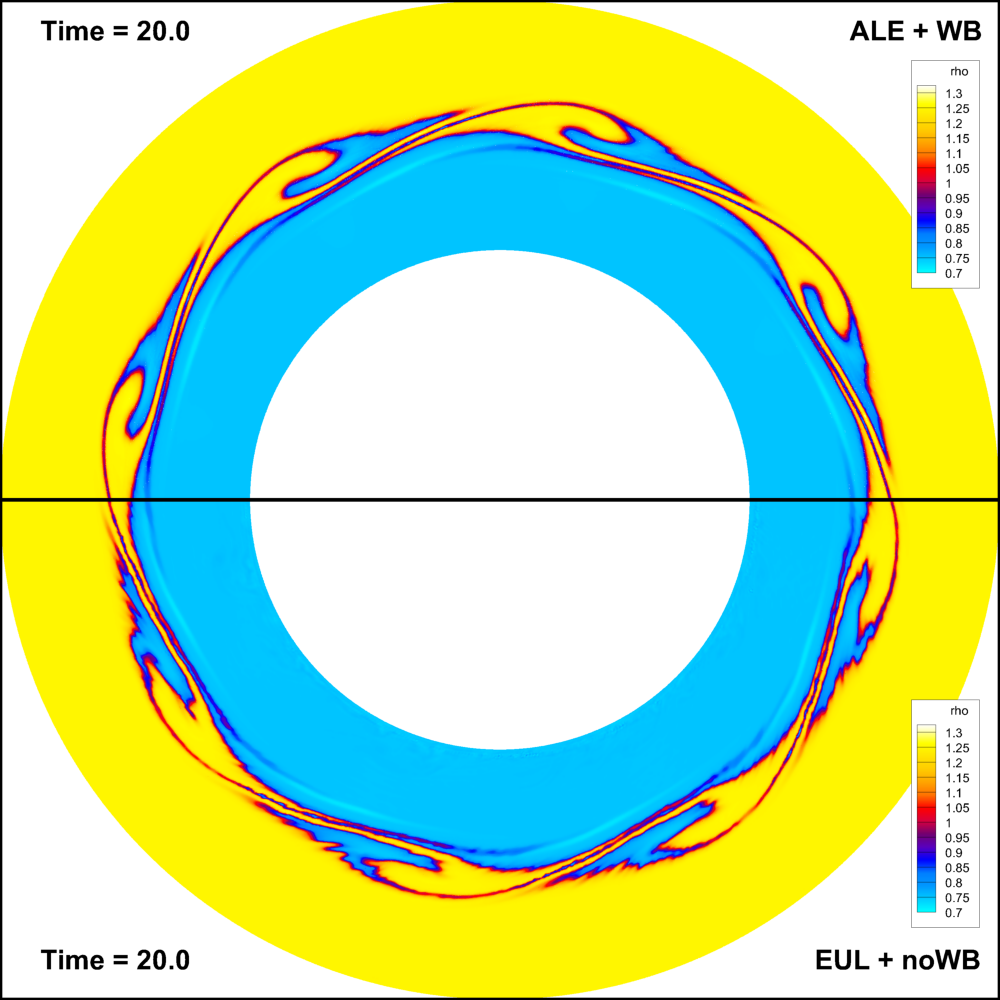
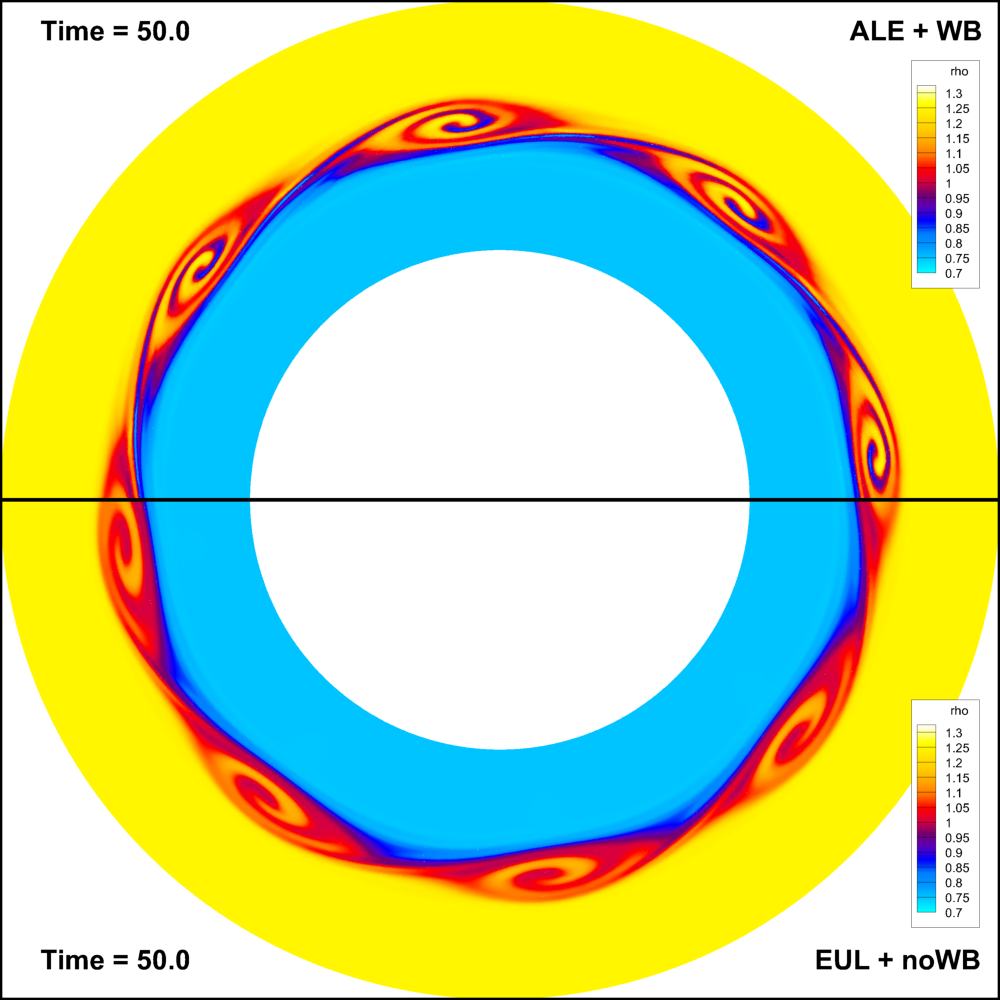
.
4) For modelling GRMHD and Einstein field equations in 3D,
being able to obtain remarkable results as the simulation of
i) black holes with extreme spin,
ii) TOV star evolved in pure vacuum,
and iii) head-on collision of two punctures black holes.
For some recent results, have a look to our preprint.
Main collaborators: M. Dumbser, O. Zanotti and I. Peshkov, University of Trento, Italy
Events
International Conference HONOM 2024:
High-Order NOnlinear numerical Methods for evolutionary PDEs: theory and applications
9-13 September 2024, Chania, Crete Island, Greece
International Conference MultiMat 2022:
Tenth International Conference on Numerical Methods for Multimaterial Fluid Flow
22-26 August 2022, Zürich, Switzerland
Journées Calcul & Simulations en Nouvelle Aquitaine
Réunir la communauté Calcul et Simulation de Nouvelle-Aquitaine pour échanger, discuter, collaborer...
6-7 December 2021, Arcachon, France